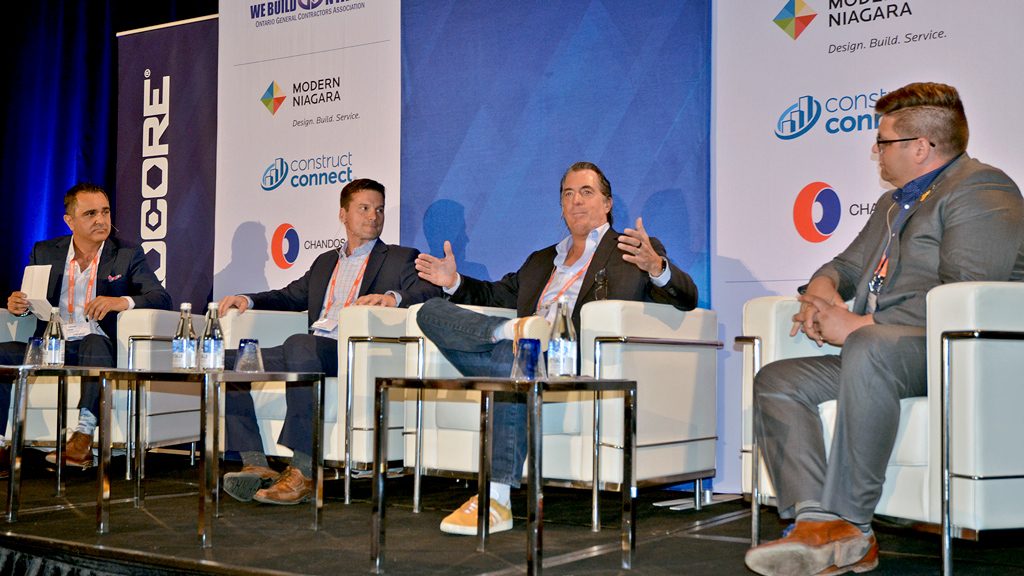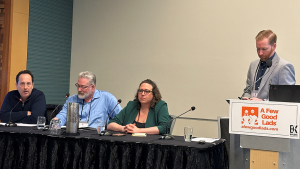The key to spearheading change when it comes to technology is getting buy-in and making people aware of how the change will benefit them, said Tooey Courtemanche, founder and CEO of Procore.
“The most effective change management is if you can connect that change to everyone at a personal level — how do I as an individual in your organization personally benefit or see the benefit out of that change,” explained Courtemanche during a panel hosted by Procore, a provider of cloud-based applications for construction, and the Ontario General Contractors Association in Toronto June 6. The panel was entitled Spearheading Change in Construction Leadership.
“It’s about what do my team members need to be healthy, happy, productive and engaged and go from there.”
The technology industry has let down construction…there has never been great technology to make jobs easier,
— Tooey Courtemanche
Procore
Mike Winters, executive vice-president and chief innovation officer, Modern Niagara, said when he first started with the company three years ago there was reluctance and resistance to innovation and change.
“Over the last three years we went from a pretty significant resistance but we are seeing a lot of that resistance breaking down and I think it’s because we were able to communicate the benefits,” said Winters.
“Innovation does not equal technology,” he added. “You can innovate by taking a 12-step process and making it five steps and removing a few handoffs and that’s innovative…If we can introduce an innovative change that will free up 15 minutes per day, they are going to be productive and it will allow them to do more meaningful work.”
While all panelists agreed construction has been one of the slowest industries to adopt technology, Courtemanche said the conversation has turned from the challenges with adopting technology to meeting the needs of the team when it comes to adoption.
“From my vantage point it has never been construction is slow to adopt technology, it has always been that the technology industry has let down construction…there has never been great technology to make jobs easier,” explained Courtemanche.
What works best and is more likely to be successful, he said, is if companies take time to talk to their people before implementing a new technology.
“When somebody comes to our firm and says we have spent time talking to our people and the biggest challenges they face getting their job done every single day are ‘A, B and C,’ do you have a solution that will help them get their jobs done as opposed to coming at it from ‘we need to buy technology and then we’re going to go tell our people here is the technology, use it,’ ” explained Courtemanche.
When implementing change, communication and awareness are key, said Winters, adding team members need to know why they are being asked to do something, what is in it for them and how it’s going to make their life better.
“It has to start with the why and what is in it for our people,” said Winters.
The fact that construction has been slow to adopt technology makes it ripe for disruption, added Winters.
“When you think of disruption, it’s Uber in the taxi industry and Airbnb in the hotel industry but Uber is not a taxi company and Airbnb is not a hotel,” he said. “They are information providers…In the next little while we could get disrupted and it could be something that comes from outside our industry.”
Tim Coldwell, president of Chandos, said his company is being innovative by using Integrated Project Delivery and lean principles to be more efficient in projects, saving time and money. He believes prefabrication will become more popular in the future.
“I believe that the future for general contractors is to be more the assemblers of key parts as opposed to co-ordinating work onsite which means that the core skill that the general contractor of the future will have will be knowledge of the global supply chain worldwide,” said Coldwell, adding automation will also play a big role.
“Wait until construction jobs disappear because of automation in the industry. I don’t think we as an industry are thinking about those implications and what responsibility we have to prepare ourselves for the future.”
The panel also touched on the labour shortage and attracting underrepresented groups such as youth, women and Indigenous people to the industry.
“In an industry that is growing faster than the economy and the labour pool is shrinking faster than other industries, your ability to compete for talent is not necessarily going to be your legacy it’s going to be, I believe, your ability to change, innovate,” said Mark Casaletto, president of ConstructConnect Canada who moderated the panel.
“We need to understand that and accept it. Resistance to change and to innovating will be a deterrent to attracting people.”










Great topic and insights. Construction is not the only industry that “technology has let down”. Based on my many years in IT trying to implement business solutions that have a positive impact on people and the industries they work in or interact with, the story is the same. Until the “what’s in it for the employee and/or customer” is consistently and genuinely addressed, any change (and especially technological change) will be met with resistance. More panels and cross industry conversations will help drive this message home to both the vendors of change and the business decision making buyers.